The Big Read: More MRT stations are popping up across Singapore but true connectivity is beyond just that

SINGAPORE: Living in Tanjong Katong, information technology consultant Benny Kosasih’s daily commute to the central business district can be unpredictable.
On good days, the trip would take just 25 minutes. On bad days - when he misses the bus to Bugis MRT Station where he then hops onto a train to Downtown Station - it stretches to about 40 to 50 minutes.
But with seven new Thomson-East Coast Line stations starting passenger service on Jun 23, the 41-year-old's commute to work has become smoother.
There is now a Mass Rapid Transit (MRT) line that takes him from Tanjong Katong directly to Shenton Way, just opposite his office, eliminating the need to take a bus and shortening his journey to 15 minutes.
“I’m really excited about it. But it’s not the same for my wife because her office is at Telok Ayer. Taking the bus to Bugis station as I did is still the fastest way for her,” said Mr Kosasih, who travels to work with his wife Yuka, a 32-year-old sales manager.
The new Thomson-East Coast Line stations opened to much fanfare, as residents living in areas such as Bayshore, Siglap, Marine Parade and Tanjong Rhu can now enjoy the long-awaited convenience of getting to town via the MRT.
Those bound for Maxwell, Outram Park and Orchard stand to gain the most, given that previously, bus journeys could take up to an hour, or about twice the time compared to now with the new MRT service.
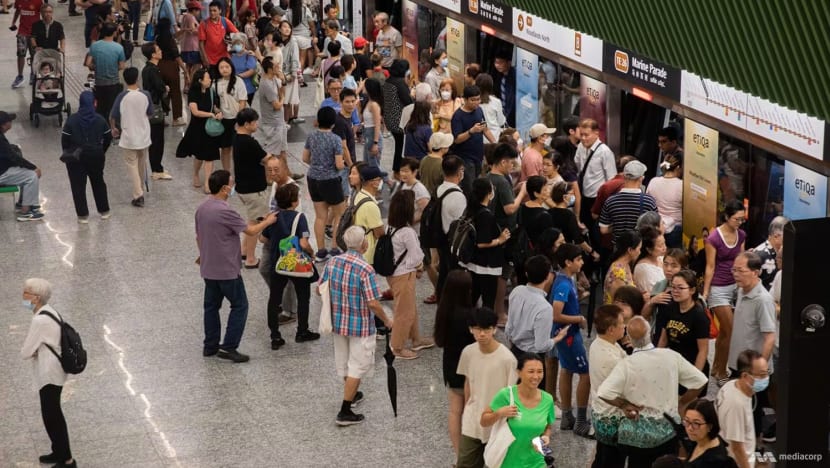
However, in several pockets of estates across the island, some residents are still left wanting, as they have no choice but to continue to rely primarily on buses to get around.
Take Changi Village, for instance, where information technology professional Cason Kong, 35, has been weighing transport choices since moving into a resale flat with his wife a few months ago.
With the nearest MRT stations at Pasir Ris and Upper Changi a 30-minute bus ride away, his main concern is the commute to his workplace in one-north, located 35km away.
“If I have time constraints, I might have to book a (private-hire vehicle). But I need to be strategic and choose the app with the lowest price, as it can be quite costly,” said Mr Kong, who has several ride-hailing apps on his phone.
Despite the remoteness, he chose Changi Village for its proximity to nature, which he finds beneficial for his well-being.
“It’s far, but I understand that they’re building the Cross Island Line, which will stop at Loyang. It is still some distance away (about 3km), but I’m sure it’ll help down the road,” he said.
The central region of Singapore is not spared from such a predicament, too. For example, in Jalan Tenteram, near Whampoa, residents either have to spend about 15 to 20 minutes to get to Novena or Toa Payoh MRT stations by bus or walk for 20 minutes to Boon Keng MRT Station.
One of them is Mr Wee Yap, a 29-year-old private-hire driver who grew up in the estate. He and his partner, Ms Rachel Chew, 28, are waiting for their Build-to-Order flat in the same estate.
“This area is quite central, but there’s no MRT station here,” he told TODAY when met at a bus stop outside Block 19. The area is served by two buses, SBS Transit service number 21 and 129, whose frequency can be as long as 25 minutes.
“Although this is considered a central area, it still feels ulu with not many shops,” Mr Wee said, using the colloquial term for an area that is remote and quiet.
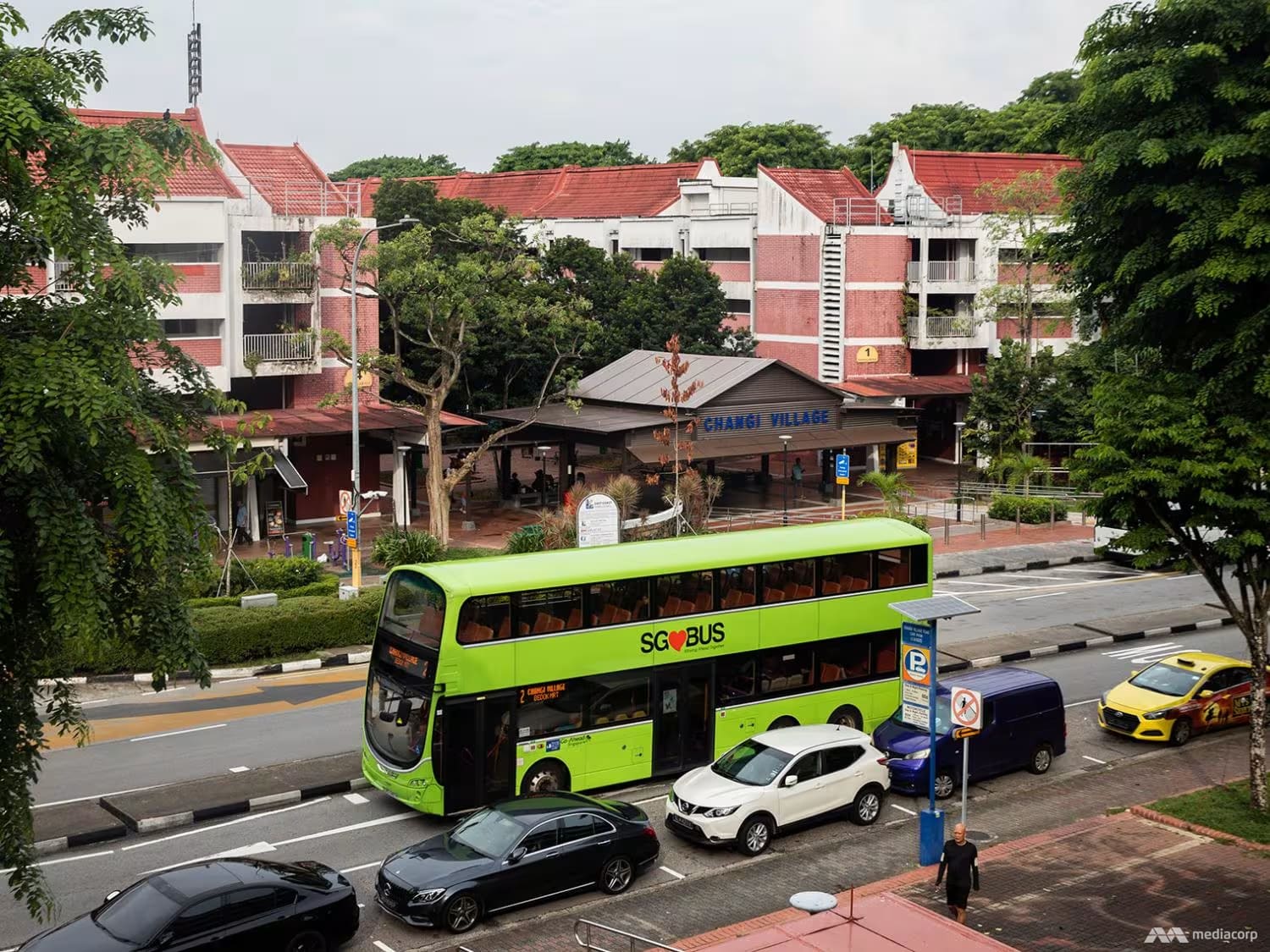
Looking ahead, more MRT stations are underway, with Prime Minister Lawrence Wong affirming at the official opening of seven new Thomson-East Coast Line stations on Jun 21 that Singapore is “certainly not done” expanding the rail network.
The Jurong Region Line and Cross Island Line are slated for completion in the late 2020s and early 2030s, respectively, and will enhance connectivity in western Singapore and link it with the eastern and northeastern regions.
Additionally, over the next decade, several new stations and extensions on current lines, like the North-South Line, Circle Line and Downtown Line, will become operational.
And by the 2030s, eight in 10 households will be within a 10-minute walk of a train station.
The ultimate goal, at least by 2040, is to transform the nation into a “45-minute city” with “20-minute towns”.
With Singapore’s public transport system often touted as one of the best in the world, TODAY takes a closer look at how the city-state compares with other major cities and what can be done to further enhance connectivity around the island.
SINGAPORE'S TRANSPORT MASTER PLAN
The target of having eight in 10 households within a 10-minute walk to a train station by 2030 has been talked about since 2013 amid continuing efforts to make Singapore a car-lite city.
Today, seven in 10 households are within the same walking distance of over 200 MRT and Light Rail Transit (LRT) stations.
To achieve the target, the government plans to invest more than S$60 billion (US$44.2 billion) in the rail network this decade.
This means that new stations or lines will open almost every year so that by the early 2030s, Singapore’s MRT network density will match that of London and New York City.
Besides this, more improvements are underway. The Land Transport Master Plan 2040 listed several recommendations on how to make Singapore’s public transport system faster and better connected.
The plan, released in May 2019, was built around three core themes: 20-minute towns, a 45-minute city, as well as safer and healthier travels.
This means that anyone can:
- Walk, cycle or ride to the nearest neighbourhood centre within 20 minutes
- Travel between their home and workplace during peak periods in less than 45 minutes
To that end, the Land Transport Authority (LTA) will expand the rail network and active mobility network (for walking and cycling), improve bus speeds, and grow the number of employment centres outside the central business district.
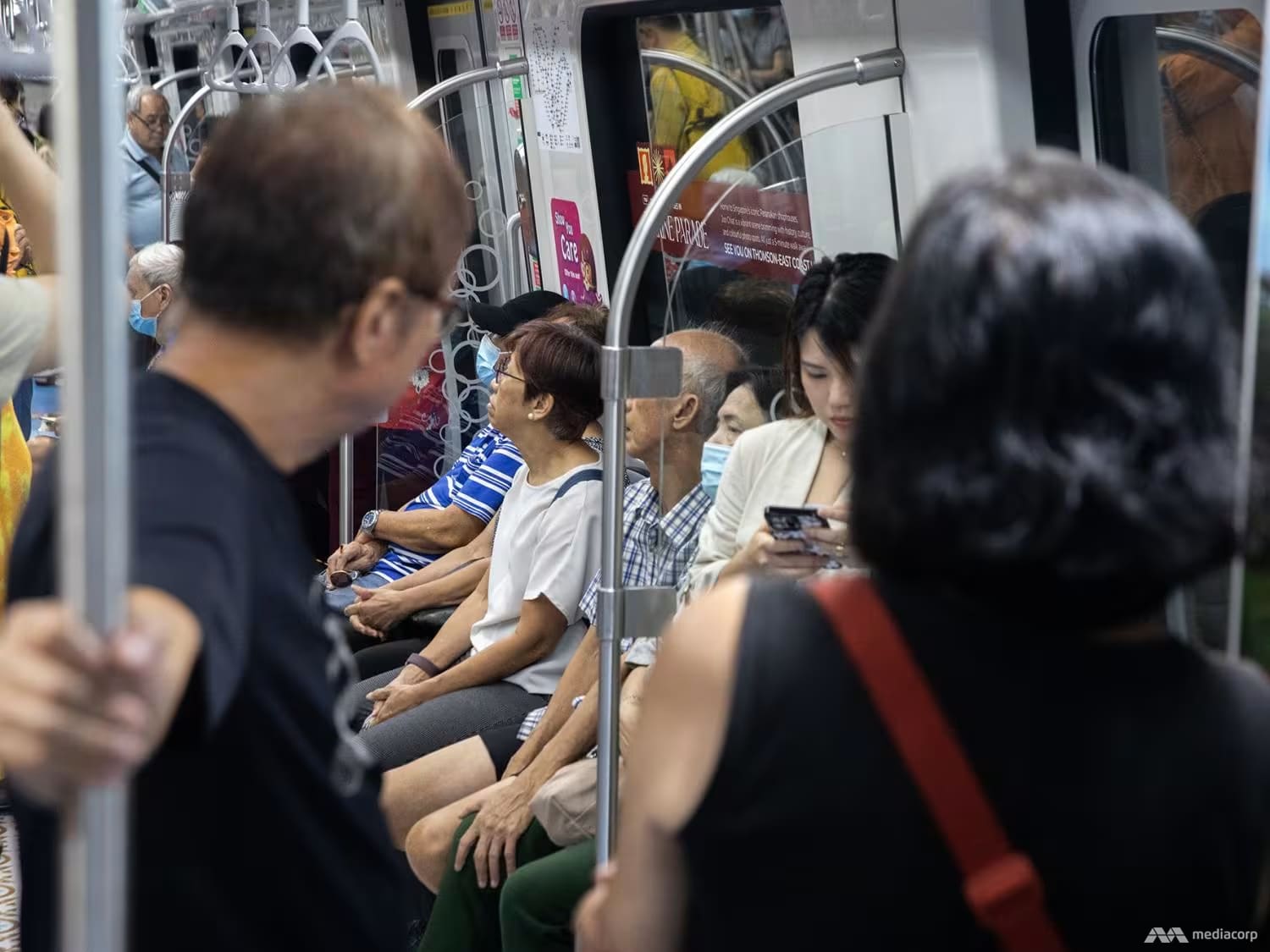
The master plan builds on a rich history of continuous development and innovation of Singapore's public transport system, which has the MRT network as its centrepiece.
“For a densely populated city like Singapore, rail remains the most efficient mode of transport,” said a LTA spokesman in response to TODAY's queries.
“That is why we have focused our planning on ensuring that more households are within walking distance of MRT stations. To serve more commuters, train stations are located in areas with higher densities of residential, retail and commercial developments.”
While the rail network forms the backbone of Singapore's public transport system, the authorities are also improving bus, cycling and walking options to improve the first- and last-mile connectivity to the rail network, said the LTA spokesman.
“For example, we have been enhancing or adding bus services to connect new housing estates to key transport nodes and other surrounding amenities,” the spokesman added.
“We have also added trips and higher-capacity buses to meet higher commuter demand.”
CONNECTIVITY ISSUES FOR SOME REMOTE AND CENTRAL ESTATES
While Singapore’s public transport system has achieved significant milestones and has ambitious plans ahead, there are still areas for improvement to provide commuters with more seamless connections, residents and transport analysts told TODAY.
Connectivity between towns is one such area. For instance, while a private-hire vehicle ride from Punggol to Canberra takes about 25 minutes, the travel time via public transport is nearly doubled.
Notably, the same issue also affects those who live and work in some centrally located areas such as Balestier and Whampoa.
Despite being in the middle of Singapore, some residents in the area feel that they might have fallen through the cracks as connectivity is still not optimal.

Shop assistant Kenny Neo has to take three buses from his home in Bukit Batok to his workplace in Balestier, which has no nearby MRT stations.
"Even though Balestier is in the central area, I wouldn't say it's well-connected. If you were to go to town, it's convenient, but to other places, and coming from other neighbourhoods, it's not convenient for me," said Mr Neo, 50.
Ideally, he would prefer a direct bus route connecting his estate to the Balestier area.
Whampoa resident Doreen Chiu said although there are a lot of buses in the area, she has always found it “quite strange” that there is no MRT station.
The 41-year-old executive assistant, who usually drives, tried taking public transport to work once. She found that she had to walk 10 minutes to the nearest bus stop and take two buses just to get to her workplace in Suntec City.
“The journey was 45 minutes. If I drive, it would only take 10 minutes.”
Whampoa residents have to take a 15-minute bus ride to Novena MRT Station or walk about 20 minutes to Boon Keng MRT Station.
In Teban Gardens, which is a 15-minute bus ride away from the nearest MRT station in Jurong East, cleaner P Ravathi, 53, said she feels the area at the western end of West Coast Road is a little lacking when it comes to public transport options.
“There’s a direct bus that takes me to where I work at HarbourFront, but it takes me one hour to get there,” she said.
When Madam Ravathi’s family travels to town, they prefer to book a private-hire vehicle. Taking the bus and MRT, along with switching lines, makes the journey to downtown areas like Orchard less convenient, she explained.
“To change so many stations really (puts a strain on my body). I always tell my daughter to quickly get her driver’s licence because I cannot (stand it).”
Homemaker Karen Chau, 60, who also lives in Teban Gardens, said her children would sometimes complain to her about living in a relatively inaccessible area of Singapore.
“I don’t really regret buying a flat here because it was what we could afford back in 1985. It’s just that travelling to other parts of the island can be a bit of a hassle, with long bus rides to Chinatown, HarbourFront and Orchard.”
The area will be served by the upcoming Pandan Reservoir MRT station on the Jurong Region Line.
Madam Chau said that while that would make travelling to other parts of western Singapore more convenient, she hopes to benefit from a rail network that could seamlessly connect her to the central areas.
EXPRESS AND FEEDER BUSES
In the far-flung Changi Village, shopowner Lim Keng Hwa, 70, who lives and works in the estate, said when she moved there 30 years ago, she did not think that transport would be a problem.
“But after years of taking a 1.5-hour bus ride to Chinatown, I wish public transport could be more convenient and faster,” she said.
“Now, I’m already 70, and still, there’s no MRT line connecting this area. Even if the nearest one is at Loyang (on the upcoming Cross Island Line), it’s still not convenient because it’s not very near here.”
Mr Hanif Mohamad, a 24-year-old hawker at Changi Village Hawker Centre, said it might be worthwhile for LTA to consider providing new express bus services so that people from nearby towns and residents have a more efficient way of getting there.
“Building a train station here might be quite tough. But having express buses from Pasir Ris, Bedok, and Tampines would be helpful,” he suggested.
“Currently, where I live in Bedok, it takes me 40 minutes to get here by bus. If I were to come here for food, it doesn’t make sense because I would be so hungry by the time I arrive.”

There are currently about 40 express bus services, which skip bus stops or travel by expressways. None of them connect Changi Village to the suggested towns.
Transport economist Walter Theseira said that the situations faced by the likes of Madam Ravathi and Madam Lim are not unique, as the MRT network was originally designed to transport people from housing estates on the outskirts to the city centre.
Hence, the network falls short in linking peripheral areas.
“While living within a five or 10-minute walk from an MRT station is beneficial for commuting to the central business district, it is less useful for travelling between peripheral areas, such as from Punggol to Yishun,” said the associate professor at the Singapore University of Social Sciences.
“This is a problem which is only being solved in recent years by newer lines like the Circle Line and the upcoming Cross Island Line.”
Assistant Professor Terence Fan from the Singapore Management University (SMU) said that for areas where it could take a while to get to the train station via bus, it would be helpful for residents to get a rail connection, perhaps with a combination of the LRT system to maintain efficiency.
On the other hand, transport engineering consultant Gopinath Menon noted that it is unrealistic to build MRT or LRT stations everywhere in Singapore.
To ensure no area is underserved by public transport, feeder buses can play a crucial role in bringing passengers to the nearest MRT station.
However, these buses also have a flip side.
“Large towns have feeder buses serving a larger area, and in some instances, the time spent using the feeder service is longer than the time spent on the MRT,” Mr Menon said.
“One option is to have more feeder services running shorter routes within large towns.”
As buses play a crucial role in linking certain estates to the MRT network, another area of concern for commuters is the frequency of feeder buses in neighbourhoods with limited services.
Cleaner Juriah Suhudi, 63, who lives at Jurong West Street 92, said that she typically waits around 20 minutes for the sole feeder bus to Pioneer or Boon Lay MRT Stations on weekends.
“I’m not good with using apps to check, so I just go out and wait, and sometimes, it really takes as long as 20 minutes. But I am already used to it,” she said, referring to SBS Transit service number 241.
According to SBS Transit's website, the frequency of the bus ranges from three to 10 minutes.
At Admiralty Link, executive assistant Mardiana Madi, 35, said while the bus taking her from her estate to Sembawang MRT Station has good frequency during peak hours on weekdays, it slows down significantly during non-peak periods and weekends.
“This is understandable, but I do think the frequency could be better. If I miss the bus, the next one is 15 to 20 minutes away. I’d rather walk to the train station since it takes about the same time on foot.”
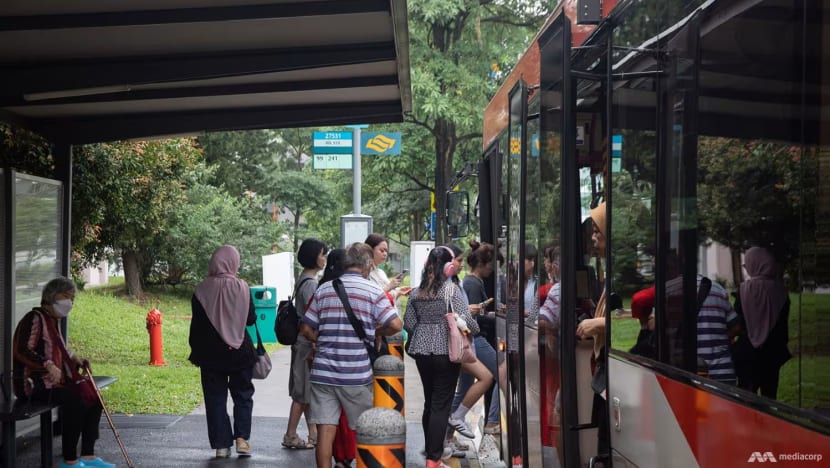
PMDs FOR LAST-MILE CONNECTIONS?
Where there are gaps in first- and last-mile connectivity, bicycles and personal mobility devices (PMDs) were often used to plug them before 2019. That was the year when the latter was banned on footpaths due to a worrying increase in PMD-related offences and accidents.
Do these devices still have a place in improving last-mile connections in Singapore now?
Assoc Prof Theseira said while PMDs were initially seen as tools for first- and last-mile connectivity, this has evolved over the years in many developed cities. PMDs are now used more for short to medium-distance travel, replacing public transport rather than supplementing it.
“For instance, in some Western and Japanese cities, people often choose to walk or cycle for short trips rather than wait for a bus. If a (bicycle or PMD) is available and the roads are conducive, it's a much better option.”
But in Singapore, the challenge lies in the fact that the current infrastructure is not designed for PMDs, as well as Personal Mobility Aids, to coexist safely with pedestrians and cars.
“Before PMDs were banned on footpaths, many owners used them for short to medium-distance commuting. Even today, some people use, or misuse, Personal Mobility Aids for the same purpose,” said Assoc Prof Theseira.
“It is important to recognise that PMDs serve this transport niche. Local buses, while useful, tend to be cost-inefficient. They need to run frequently to be practical for commuters, yet they often lose money during non-peak periods.”
Mr Saktiandi Supaat, who is chairperson of the Government Parliamentary Committee for Transport, said that while the future of PMDs remains uncertain due to footpath safety concerns and battery issues, bicycles continue to thrive where safe cycling paths are available.
“Bicycles are particularly advantageous for longer distances just beyond a 10-minute walk, offering cost savings and health benefits.
“The generous bicycle parking facilities at the newly opened Marine Parade MRT Station are a good example of accommodating cycling infrastructure,” said Mr Saktiandi, who is also a Member of Parliament for Bishan-Toa Payoh Group Representation Constituency.
According to LTA, Singapore now has 525km of cycling paths, and this will soon be expanded to around 1,300km by 2030, connecting commuters to MRT stations, bus interchanges and nearby shopping malls and schools.
“We are also re-purposing roads to prioritise road space for pedestrians and cyclists, including creating Transit Priority Corridors. These corridors are integrated with bus lanes, wider footpaths and dedicated cycling paths, or shared paths,” said the LTA spokesman.
HOW SINGAPORE STACKS UP AGAINST OTHER CITIES
Despite some gaps, Singapore's public transport system has consistently ranked high in international surveys and is described as “world-class”, putting the Republic on par with other major cities such as Hong Kong, London and Tokyo.
According to the Urban Mobility Index Ranking 2023 by American consulting firm Oliver Wyman Forum, Singapore ranked third place for public transit, with Hong Kong, and Zurich in Switzerland, coming in first and second, respectively.
This is based on public transit density, utilisation rate and efficiency.
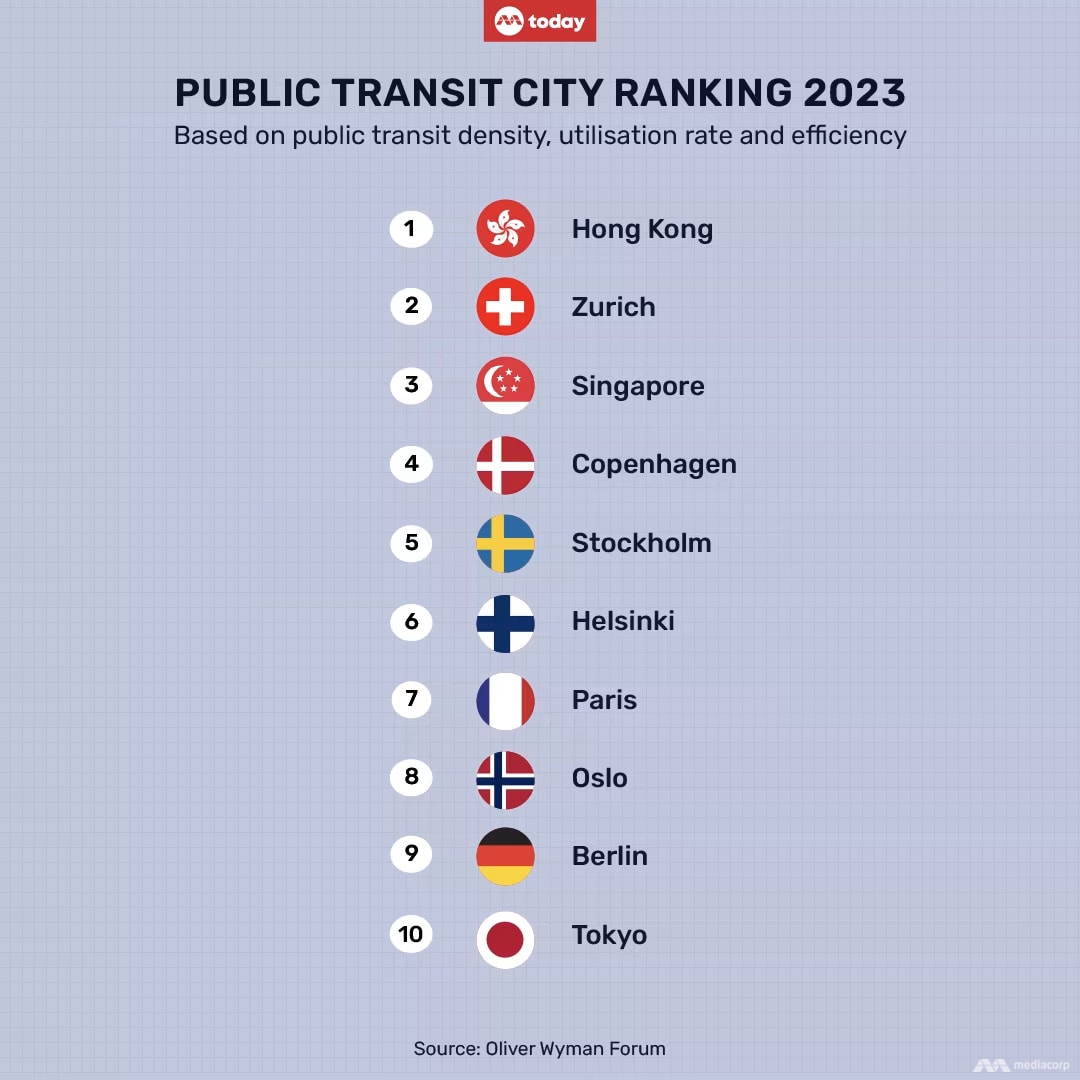
In Timeout Magazine’s 2023 survey of 20,000 city dwellers from over 50 cities, Singapore ranked 6th, above Hong Kong, Taipei, London, and Paris.
Respondents were simply asked whether it was easy to get around their city by public transport.
While Singaporeans started to enjoy the benefits of having an MRT system just some 40 years ago, Londoners have had a much longer experience of going “underground”.
London’s Underground, or the Tube, which opened in 1863, is one of the oldest and most extensive subway systems globally, with 11 lines spanning 402km.
Dr Fan of SMU said that the Tube, while extensive, has pockets of residential areas that are somewhat distant from train stations.
“These gaps can be found even in the downtown area, where coverage can be patchy.
“London's overall population density is lower than Singapore’s, with fewer high-rise residential buildings, which affects the distribution and accessibility of public transport,” he said.
Dr Fan said that Singapore's public transport network is more comparable to Tokyo's due to its extensive coverage and the two cities' high population density.
“However, Tokyo's metropolitan area is larger than Singapore. So when you move towards the outer wards, there will definitely be pockets of areas where public transport coverage is less consistent,” he said.
Another major city’s transport system often compared with Singapore's is the New York City Subway, the largest in the world by the number of stations (472).
Despite its vast coverage and 24-hour operations, the system faces challenges such as delays, ageing infrastructure, and cleanliness issues, areas where Singapore's system excels, according to one American citizen.
Mr Jay Suresh, a 21-year-old American who works as an intern in a Singapore technology firm, also said that although the subway is the most convenient way of getting around New York, he finds that most stations are not strategically placed near where people live.
“So very often, people find themselves walking more than the time taken via the subway to work.
“Whereas in Singapore, the stations are near HDB (Housing and Development Board public housing) areas. But then again, Singapore is smaller, so it’s understandable.”
Just by looking at the maps, although New York and London boast much more complex networks, transport experts said it is difficult to make an apple-to-apple comparison with Singapore as the contiguous built-up areas and characteristics of different cities are not the same.
Assoc Prof Theseira said some common metrics could be considered, such as how much of the population is within a certain distance of train stations and bus stops, the average amount of time spent on public transport, the cost, and the total distance covered.
However, he cautioned that these might not be the most objective way of comparison, as these factors are often influenced by other policies, such as traffic congestion control measures, the general layout of the city, and the overall quality of the public transport network.
“People could be spending more time on public transport because a city is poorly connected or there is a lot of traffic congestion.
“We have to look at it from a holistic point of view as the city’s context and public transport objectives will have an impact,” he said, adding that this combination makes direct comparisons between different cities a bit tricky.
Dr Fan said that Singapore may be well-connected by global city standards, but within the local context, there is room for improvement.
He explained that in places like London and some North American cities, having good bus service within a 15-minute walk is considered a highly valued feature in property advertisements.
“But in Singapore, where most Singaporeans don’t have (similar) access to private vehicles and taxi and private-hire rates have risen sharply, a reliable transport system is essential.
“Very often, if you live in the wrong part of the island, you can’t take jobs and meetings that are further away. And this is something our transport system should aspire to address,” said Dr Fan.
PUBLIC VS PRIVATE TRANSPORT TRAVEL TIME
Comparing the travel times of public and private transport can lead to long sighs or headshakes from affected commuters due to the marked difference.
In 2020, the Department of Statistics reported that the median travel time for residents commuting to work via MRT/LRT and public bus was 60 minutes.
On the other hand, those using private transport, including cars, taxis, private-hire vehicles, and motorcycles, enjoyed a significantly shorter median travel time of 30 minutes.
This disparity reflects the inherent nature of public transport, which serves an array of needs by stopping at various locations - an inevitable part of commuting here.
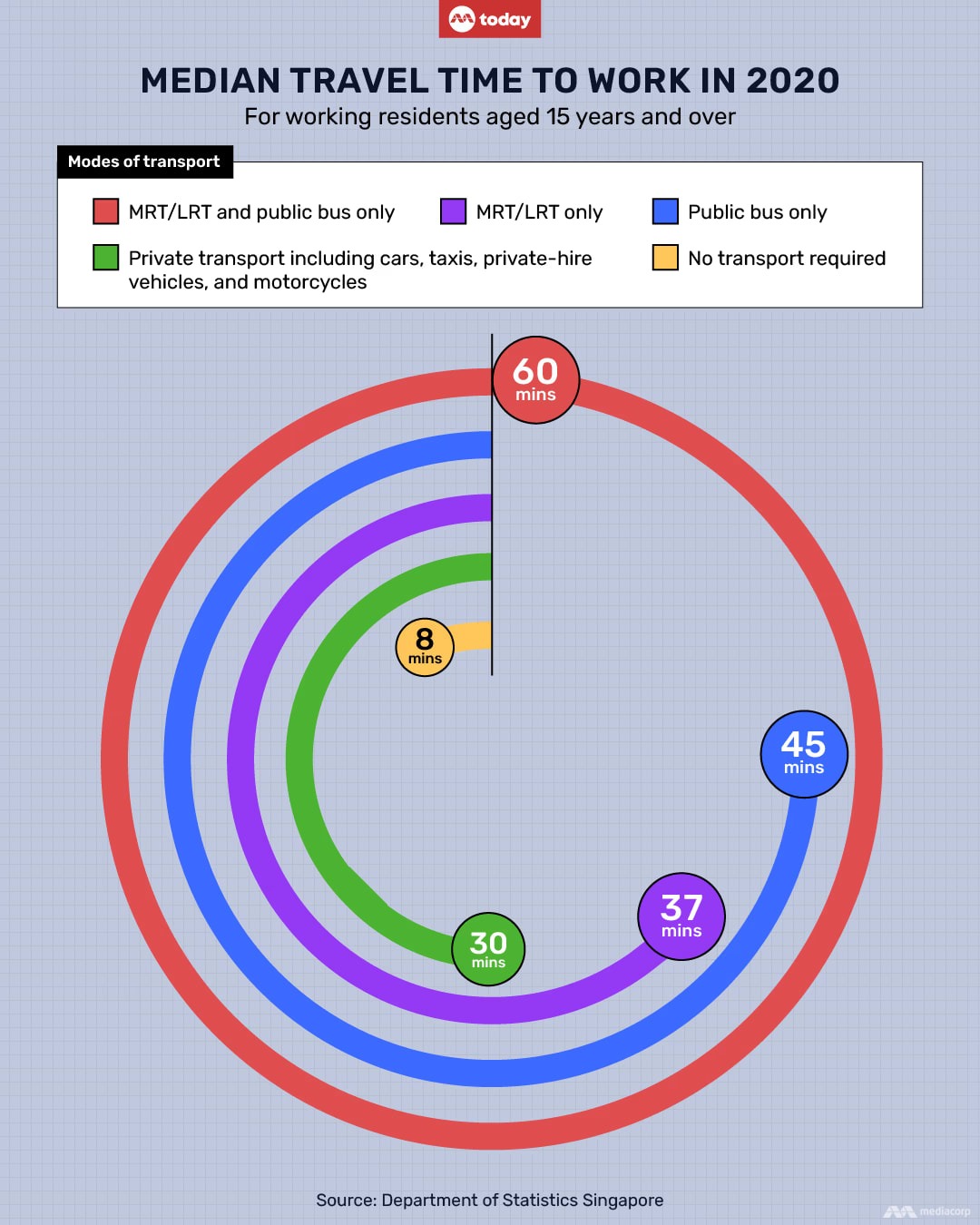
Given this context, some experts said it may not be fair to assess Singapore's connectivity simply by comparing the travel times using public and private transport.
Mr Menon, the transport engineering consultant, said that public transport will always be slower than private transport in a country like Singapore, where “acute” traffic congestion is rare.
“Hence, it is not a fair comparison,” he said.
Assoc Prof Theseira concurred, saying that travel times alone do not capture the full picture. He explained that Singapore's unique context combines the efficiency of the public transport system with people's residential and workplace choices, their earning power, and the job concentration in different areas.
“First off, jobs in Singapore are heavily concentrated in two main areas: The central business district and secondary business districts like Jurong.
“On the flip side, most residential areas, especially for middle- and lower-income folks, are located in the outlying HDB estates. So as a result, these groups tend to have longer travel times.”
Conversely, high-income groups often have shorter travel times because they usually own cars, and they can “live wherever they want”, said Assoc Prof Theseira.
“If you look at people living in Katong, Bukit Timah, if they work in the city, they have shorter commutes due to driving or being close to public transport."
Assoc Prof Theseira said another reason for the gap in Singapore's public and private transport travel time is the government’s strict control on private transport ownership, especially of cars, which greatly reduces traffic congestion.
"In London, I find that even high-income individuals who work in central London prefer public transport. If you ask them, 'Why do you take the Tube when you can easily afford a car?', they would say, 'Why would I drive? Driving would take twice as long as taking the Tube’.”
In the Singapore context, taking private transport can sometimes be faster than public transport even during rush hour, said Assoc Prof Theseira.
“But this is not true in many other large cities …. in places like London, New York and Tokyo … taking private transport (is) a bad idea because the relative lack of control on car ownership and the layout of city streets make private transport very time-consuming.”
As for the LTA's Land Transport Master Plan 2040, transport analysts described its goals of 25-minute towns and a 45-minute city as ambitious but within reach.
Dr Fan said the high Certificate of Entitlement prices now indicate the increasing priority that Singaporeans place on time, and how people are willing to spend more to reduce commute times.
"Many people currently spend about an hour commuting one way, and reducing this time would be significantly beneficial. By cutting average commutes to 45 minutes or less, 15 minutes saved one way will be quite meaningful for the overall economy."
Likewise, Assoc Prof Theseira said the master plan’s targets focused on reducing inefficiencies and delays.
However, beyond the time targets, he emphasised the importance of examining transport equity. This means ensuring that people living in different parts of Singapore and with varying economic statuses have access to decent transport options.
"It's not just about improving the average (travel time) but making the distribution more uniform so that no Singaporeans are strongly disadvantaged."

No comments
Share your thoughts! Tell us your name and class for a gift (: